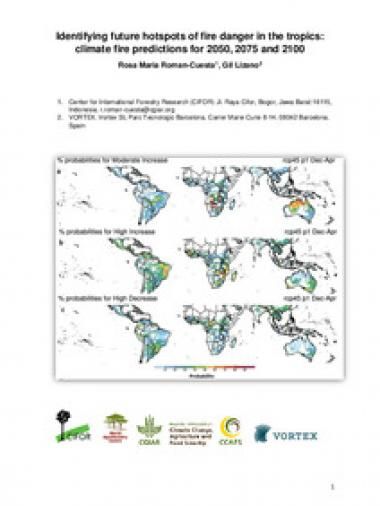Identifying future hotspots of fire danger in the tropics: climate fire predictions for 2050, 2075 and 2100

Recent bursts in the incidence of large wildfires worldwide have raised concerns about the influence
that climate and humans may have on future fire activity. Climate strongly influences global wildfire
activity, and recent wildfire surges may signal fire weather-induced pyrogeographic shifts. Fire weather
seasons have lengthened across ca.3 0 million km2 (25 % of the Earth’s vegetated surface), resulting
in an 19% increase in global mean fire weather season length, which would allow for a doubling of the
global burnable area affected if these fire weather changes were coupled with ignition sources and
available fuel, which are largely controlled by humans.
Disagreement exists on the relative importance of climate versus human drivers in shaping global fire
regimes, with a particular gap in the pantropical region where fire has had a long presence in savannas,
montane grasslands and dry forest ecosystems, but it has had a much more recent, infrequent and
unknown role in many moist forest ecosystems such as rainforests and cloud montane forests. Either
climate or human induced, scenarios of future increases in burned area (fire danger) are needed to i)
navigate fire danger reduction policies (e.g fire management that controls prevention, suppression and
restoration), ii) to understand how to improve fire-resilient landscapes, iii) to reduce Greenhouse Gas
emissions from fire, particularly in regions with carbon-dense fires, and iv) to support capacity building
for effective fire management development and implementation.
In this research we map pantropical future fire danger in 2050 (2025-2049), 2075 (2050-2074), 2100
(2075-2099). Fire danger is here understood as the probability of fire spreading over more extended
areas under severe climatic conditions (precipitation, temperature and drought), under more extreme
future conditions determined by the CMIP5 data. Because human decisions on the land are difficult to
model and project in the future, we here focus on projecting climate-driven fire danger only.
Citation
Roman-Cuesta RM, Lizano G. 2020. Identifying future hotspots of fire danger in the tropics: climate fire predictions for 2050, 2075 and 2100. Wageningen, The Netherlands: CGIAR Research Program on Climate Change, Agriculture and Food Security (CCAFS).